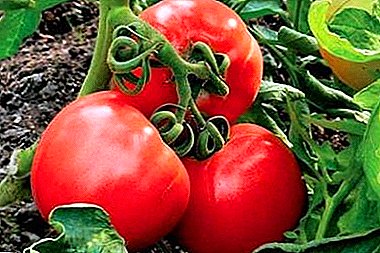
Life expectancy and health of poultry are more dependent on the characteristics of its diet.
Unfortunately, in most cases, birds often feed improperly, due to a lack of knowledge about their digestive system.
Therefore, it is extremely important to have an idea of what the chickens' digestive tract is and why goiter is blocked in them. About this further.
The structure of goiter and digestive system in chickens
The digestive system of chickens has its own morphological features, which is associated with their adaptation to flight:
- The rapid passage of food through the digestive tract. The higher the rate of passage of food masses, the more likely the productivity of the bird will be.
- Intensive and rapid digestion, absorption and absorption of nutrients from food entering the body of a bird.
- High plasticity and adaptability to the nature of the feed that chickens feed on.
- The digestive process in poultry can be divided into several stages, so that it is clear how it digests food.

Digestive system in chickens
Oral digestion. Smell and taste buds play a secondary role for chickens: they detect food through sight and touch.
reference. Since chickens have exclusively "day vision", which is connected with the peculiarities of the structure of their eyes, the amount of food eaten directly depends on the duration of the light regime. So, even a very starved bird will not eat shaded feed.
Since chickens do not have teeth, they grab food with a short, hard beak, in which a large number of not very well developed salivary glands are located, emitting a little saliva.
Goiter digestion. After food gets into the beak, it gradually descends into the goiter. This is a special expansion of the esophagus, which is characteristic of all granivorous birds. Goiter has two openings: input and output. Both are limited to sphincters. The capacity of this department is about 120 g of feed. Duration of food in it ranges from 6 to 18 hours. This indicator depends on the type of food: wet and soft for a long time in the goiter does not linger.
Goiter and stomach are closely interrelated. So the fullness of the first strongly influences the secretory function of the second. An empty stomach stimulates the food-filled goiter to release, causing it to contract. A full stomach slows goiter motility. Goitre contractions have a peristaltic form and it is they that provide feed to the stomach for further digestion.
Digestion in the stomach. The bird's stomach is represented by two sections: glandular and muscular. The first is very small and the food in it practically does not linger. In fact, the glandular part of the stomach serves as a supplier of gastric juice and no more. The main gastric digestion occurs in the muscle section, but it boils down to the fact that food is compressed and ground.
What is a blockage of goiter, the causes of the disease
Goiter blockage or its overflow is a rather dangerous disease, which is expressed in overcrowding of the goiter with fodder masses and, therefore, loss of tone in this part of the digestive tract. As a result, there is complete or partial obstruction. The disease is very dangerous, because, as you know, goiter plays an important role in the poultry's digestive system, supplying food to the stomach.
Birds suffering from the disease in question have a strongly swollen goiter, which on palpation somewhat resembles dough. It is very easy to detect the disease, since the hen with a clogged goiter is characterized by lethargy and, of course, a very swollen bag.

Unfortunately, virtually all breeds of chickens are subject to blockage of goiter, but the extent of the disease depends solely on the type of food poultry. If the owner of the chicken feeds them incorrectly, the disease will definitely manifest itself.
The causes of the blockage of goiter may be different. So, most often the following:
- Wrong power mode. If the farmer feeds the poultry with long time interruptions, hungry chickens will eagerly pounce on food, trying to push as much feed as possible into the goiter. In this case, the goiter can quickly fill up, which will lead to its blockage.
- Many large items in the feed. Goiter blockage can occur during long-term ingestion of large particles of feed (for example, hay, straw, leaves). Sometimes, by chance, chickens can swallow branches and hard stems that do not go through the goiter with feed.
- Poor nutrition. Too coarse, heavy or expired food digests slowly enough, which leads to a slow emptying of the goiter, and, accordingly, a gradual blockage.
- Shortage of drinking water. Water stimulates pushing food from the goiter to the stomach and an insufficient amount of it can lead to a slowdown in the movement of feed through the digestive tract.
- Vitamin fasting birds. If the diet of the bird does not have enough vitamins and minerals, especially vitamins of the group (B2 and B12) and choline, this can contribute to the development of the disease.
Symptoms and course of the disease
When a goiter becomes blocked in a bird, the disease usually manifests itself with easily identifiable symptoms:
- Increased in volume dense goiter. When probing it is clearly felt the grain and other components of the feed.
- The hen moves a little, behaves very sluggishly. Often sits or stands, lounging or opening the beak.
- Sick chicken refuses to feed.
- Breathing becomes difficult or intermittent. In some cases, clear fluid is released from the nose of the birds.
In addition to the general symptoms of the development of the disease, one can notice gradual oppression of a sick bird, which, when walking, practically does not move and refuses with time not only food but also water. The walls of the goiter begin to stretch and gradually translucent. If the disease is badly started, the bird starts to lose weight rapidly, its egg production decreases.
Important. Timely detection of the disease is the key to its successful treatment, since during the long course of the disease complications arise: the goiter and intestines become inflamed. When the disease becomes chronic, the esophagus, liver and kidneys are disturbed.
Diagnostics
The disease is easily determined by visual signs: bloated goiter, loss of appetite and weak overall activity of the chicken.
On palpation, it is possible to determine that a large amount of food has accumulated in the goiter, which does not pass further into the stomach.

For a more accurate diagnosis of blockage of goiter, veterinarians are advised to check the entire population in the morning before feeding the birds.
During the night, all the food from the goiter should get into the stomach. If this does not happen, then chickens are diagnosed with a goiter obstruction.
Treatment
In case a goiter blockage was detected at the earliest stage, its contents can be easily softened. To do this, use liquid paraffin, warm water or a few spoons of vegetable oil. These ingredients to choose from must be given to the chicken with a syringe without a needle.
Then you need to gently massage the goiter with your fingers, after which the bird is turned upside down to slightly shake the contents of the goiter. However, we must remember that the bird should be returned to its usual position every 10 secondsso that she can breathe normally.
Sometimes for the same purpose you can use the usual potassium permanganate. It is enough to dissolve a couple of drops of this substance in a glass of water, bringing it to a light pink color. Half of the glass should be poured into the bird with a rubber tube lubricated with petroleum jelly. As a rule, the food is washed out of the goiter for 3 such leaching.
Unfortunately, such treatment methods are not suitable for birds that have swallowed large branches. In this case, you should call the veterinarian, who, under general anesthesia, will open the goiter and get all the contents that interfere with the normal feeding of the bird.

Prevention
The most effective prevention of goiter obstruction is considered observance of all poultry standards.
Chickens should be fed properly, and the intervals between feedings should be the same. As for the portions, they should not be large, so that the bird does not have a desire to eat more than it can itself.
Also in the fight against this disease will help to periodically check the entire population of birds for the presence of bloated goiter. It is necessary to do such a check in the morning, before the first feeding, in order to eliminate the normal bloating of this organ.
To protect domestic chickens from such an unpleasant and dangerous disease as a blockage of goiter, it is necessary to provide them with nutritious nutritious food and clean water (sometimes you can add a little apple cider vinegar, which improves the digestive process).
Moreover, it should be done according to a certain schedule (food should be fed to the feeders 2 times a day, preferably at the same time). In addition, it is worthwhile to periodically inspect the bird in order to identify any changes in its appearance and to conduct a series of therapeutic measures (if necessary).












